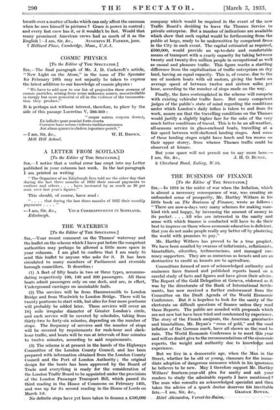THE WATERBUS
[To the Editor of THE SPECTATOR.] SIIL—Your recent comment on the Thames' waterway and the leaflet on the scheme which I have put before the competent authorities may perhaps be allowed a little more space in your columns. I am glad to confirm that I am ready to send this leaflet to anyone who asks for • it. It has been circulated to many members of Parliament and riverside borough councillors. It describes : (1) A fleet of fifty boats in two or three types, accommo- dating respectively 100, 140 and 200 passengers. All these boats admit passengers only on one deck, and are, in effect, Underground carriages on unsinkable hulls.
(2) The services will be from Hammersmith to London Bridge and from Woolwich to London Bridge. There will be twenty pontoons to start with, but sites for four more pontoons will probably be added later. These services will cover an 181 mile irregular diameter of Greater London's circle, and each service will be covered by schedules, taking from thirty-two to forty-six minutes, depending on the number of stops. The frequency of services and the number of stops will be covered by requirements for rush-hour and slack- hour traffic, and boats will be run at intervals of four minutes to twelve minutes, according to said requirements.
(3) The scheme is at present in the hands of the Highways Committee of the London County Council, and has been prepared with information obtained from the London County Council and the Port of London Authority ; the original design for the boats has been approved by the Board of Trade and everything is ready for the consideration of the London Traffic Board to be appointed under the provisions of the London Passenger Transport Bill, which passed its third reading in the House of Commons on February 14th, and was up for its second reading in the House of Lords on March 1st.
No definite steps have yet been taken to finance.a £500,.009
company which would be required in the event of the new Traffic Board's deciding to leave the Thames Service to privite enterprise. But a number of indications are available which show that such capital would be forthcoming from the public at large, ready to be underwritten by competent firms in the City in such event. The capital estimated as required, £500,000, would provide an up-to-date and, comfortable means of transport with a-yearly capacity fog taking between twenty and twenty-five million people in occupational as well as casual and pleasure traffic. This figure marks a startling difference from the capitalisation of traffic enterprises on dry land, having an equal capacity. This is, of course, due to the use of modern boats with oil motors, giving the boata• an average speed of between twelve and sixteen miles per hour, according to the number of stops made on the way.
Finally, the fares contemplated in the scheme will compete with existing vehicular traffic fares. But many competent judges of the public's state of mind regarding the conditions under which London's daily influx is taken to and from its work, assure me that the travelling conditions on the Thames would justify a slightly higlier fare for the sake of the very much better conditions of travel. This is to be an all-weather, all-seasons service in glass-enclosed boats, travelling at a fair speed between well-sheltered landing stages. And some of these landing stages might have lunch and tea rooms on their upper storey, from whence Thames traffic could be observed at leisure.
But your space will not permit me to say more here.—
I am, Sir, &c., J. H. 0. BURGE. 3 Cleveland Road, Ealing, W.13.


















































 Previous page
Previous page